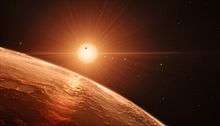2017 MB7
| Discovery [1] | |
|---|---|
| Discovered by | Pan-STARRS 1 |
| Discovery site | Haleakala Obs. |
| Discovery date |
22 June 2017 (first observed only) |
| Designations | |
| MPC designation | 2017 MB7 |
|
TNO [2] · centaur damocloid [3] · distant [1] | |
| Orbital characteristics [2] | |
| Epoch 23 March 2018 (JD 2458200.5) | |
| Uncertainty parameter 2 | |
| Observation arc | 147 days |
| Aphelion |
8100 ± 500 AU 2000 AU (1600 barycentric) 1600 AU (2017 barycentric) 2800 AU (2400 barycentric)[4] |
| Perihelion | 4.44830 ± 0.00007 AU |
|
4100 ± 300 AU 1000 AU (1600 barycentric) 780 AU (2017 barycentric) 1400 AU (2400 barycentric) | |
| Eccentricity | 0.99890 ± 0.00007 |
|
260,000 ± 20,000 yr (94 million days) 33,000 yr (1600 barycentric) 22,000 yr (2017 bayrcentric) 54,000 yr (2400 barycentric) | |
| 0.0019 ± 0.0002° | |
| 0° 0m 0.014s ± 0° 0m 0.001s / day | |
| Inclination | 55.7197 ± 0.0001° |
| 58.2476 ± 0.0002° | |
| 80.507 ± 0.002° | |
| Earth MOID | 3.94041 AU |
| Jupiter MOID | 1.78181 AU |
| Saturn MOID | 0.1442 AU |
| TJupiter | 1.474 |
| Physical characteristics | |
Mean diameter |
3–10 km (assumed) 5–13 km (damocloid) |
|
0.05–0.3 (assumed) 0.03–0.1 (damocloid) | |
|
21.18 (2017-Feb peak) 22.13 (2018 peak) ~47 (aphelion) | |
| 14.156 ± 0.33234 | |
|
| |
2017 MB7 is a centaur and probable damocloid in the outer Solar System, approximately 8 kilometers (5 miles) in diameter. It was first observed on 22 June 2017 by the Pan-STARRS survey at Haleakala Observatory in Hawaii, United States. It is notable for having a larger heliocentric aphelion than any other known asteroid, with an aphelion of 7,000–9,000 astronomical units (AU). Coming second is 2014 FE72 with an aphelion of only ~4,000 AU.
Orbit
2017 MB7 is by far the most distant and eccentric known asteroid orbiting the Sun, varying in its distance from the Sun over its orbit by 99.89% from slightly within the orbit of Jupiter, to more than 7,000 times Earth's distance to the Sun. While its orbit extends to the inner Oort cloud, it may not be a member of it, as it approaches very near to Saturn, implying Saturn has either captured a past Oort Cloud object onto this orbit, or it was a centaur ejected by Saturn from a much smaller orbit. However, it would be impossible to project its orbit far enough into the past to determine which scenario is true.
Like most objects on an extremely distant orbit around the Sun, 2017 MB7's barycentric orbit is very different from its heliocentric orbit, the latter being based only on the current position of the Solar System barycenter, and the former is based on the long-term movement of the barycenter. While the heliocentric aphelion is 7,000–9,000 AU, depending on the calculation, the current barycentric aphelion (as of 2018) is only 1,700 AU. Before it approached the Sun in 2016 AD (after last approaching around ~30500 BC), it reached only 2,000 AU from the sun around ~14300 BC.
Physical characteristics
Assuming it is a typical damocloid,[3] 2017 MB7 likely has a dark albedo, or amount of light that it reflects, which would mean it is likely in the size range of 5–13 kilometers. Like other distant objects, it is probably also fairly red in appearance due to tholins on its surface. Very little is known for certain about its physical characteristics.
References
- 1 2 "2017 MB7". Minor Planet Center. Retrieved 25 February 2018.
- 1 2 "JPL Small-Body Database Browser: (2017 MB7)" (2017-12-13 last obs.). Jet Propulsion Laboratory. Retrieved 25 February 2018.
- 1 2 Johnston, Wm. Robert (30 December 2017). "List of Known Trans-Neptunian Objects". Johnston's Archive. Retrieved 22 March 2018.
- ↑ Horizons output. "Barycentric Osculating Orbital Elements for 2017 MB7". Retrieved 2018-02-25. (Solution using the Solar System Barycenter and barycentric coordinates. Select Ephemeris Type:Elements and Center:@0)

